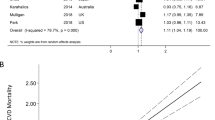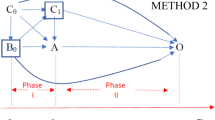Abstract
Under usual practice in epidemiologic research, covariate adjustment would be used to control for confounding effects. Exclusions, on the other hand, are justified as a part of an analytic strategy when there is evidence of an interaction altering the shape or direction of the exposure–-outcome relationship across strata. This distinction applies with particular relevance in the analysis of the BMI–-mortality relationship. Both covariate adjustment and exclusions have been used, with the need to control for interaction usually justified by concerns of reverse causality. The concern of reverse causality arises when conditions prevalent at baseline are thought to be associated with both lower average body weight and higher mortality risk, as would be the case with smokers. In the analysis, the choice must be made of whether to control for smoking status or exclude smokers altogether. Unfortunately, reverse causality is difficult to test for directly in observational data as deletions of very large subsets of the data can also lead to a different result, by chance alone. Findings that result after large-scale exclusions must therefore be tested in the standard statistical framework that can distinguish any new result observed after exclusions from one that could have occurred solely by chance. In statistical tests focused specifically on this question, the weight of the evidence suggests that interactions are not present in this context and that exclusion of subgroups (e.g., by smoking status, age, sex, use of alcohol) leaves the shape of the mortality curve unchanged, although it may alter the absolute level of risk. Unless some special question is being asked about subgroups, the author advises against large-scale exclusions for a common trait in analyses of the BMI–-mortality relationship and emphasizes using representative study samples with measured exposure variables. A large-scale social experiment is cited that gives some evidence on the effect of a population-wide downward shift in BMI.
This is a preview of subscription content, access via your institution
Access options
Subscribe to this journal
Receive 12 print issues and online access
$259.00 per year
only $21.58 per issue
Buy this article
- Purchase on Springer Link
- Instant access to full article PDF
Prices may be subject to local taxes which are calculated during checkout





Similar content being viewed by others
References
Manson JE, Stampfer MJ, Hennekens CH, Willett WC . Body weight and longevity. A reassessment. JAMA 1987; 257: 353–358.
Garrison RJ, Feinleib M, Castelli WP, McNamara PM . Cigarette smoking as a confounder of the relationship between relative weight and long-term mortality. The Framingham Heart Study. JAMA 1983; 249: 2199–2203.
Pearl R . Alcohol and Longevity. Alfred A. Knopf: New York, 1926.
Corrao G, Rubbiati L, Bagnardi V, Zambon A, Poikolainen K . Alcohol and coronary heart disease: a meta-analysis. Addiction 2000; 95: 1505–1523.
Shaper AG . Alcohol and mortality: a review of prospective studies. Br J Addict 1990; 85: 837–847.
Fagrell B, De Faire U, Bondy S, Criqui M, Gaziano M, Gronbaek M et al. The effects of light to moderate drinking on cardiovascular diseases. J Intern Med 1999; 246: 331–340.
McMichael AJ, Woodruff RE, Hales S . Climate change and human health: present and future risks. Lancet 2006; 367: 859–869.
Flegal KM, Graubard BI, Williamson DF, Gail MH . Excess deaths associated with underweight, overweight, and obesity. JAMA 2005; 293: 1861–1867.
Sempos CT, Durazo-Arvizu R, McGee DL, Cooper RS, Prewitt TE . The influence of cigarette smoking on the association between body weight and mortality. The Framingham Heart Study revisited. Ann Epidemiol 1998; 8: 289–300.
Durazo-Arvizu RA, Cooper RS . Issues related to modeling the body mass index–mortality association: the shape of the association and the effect of smoking status. Int J Obes 2008; 32(Suppl 3): S52–S55.
The BMI in Diverse Populations Collaborative Group. Effect of smoking on the Body Mass Index-mortality relation. Empirical evidence from 15 studies. Am J Epidemiol 1999; 150: 1297–1308.
Adams KF, Schatzkin A, Harris TB, Kipnis V, Mouw T, Ballard-Barbash R et al. Overweight, obesity, and mortality in a large prospective cohort of persons 50–71 years old. N Engl J Med 2006; 355/8: 763–778.
Durazo-Arvizu R, Luke A, Prewitt TE, McGee D, Cooper RS . Relative weight and mortality risk in US blacks and whites: Findings from representative national population samples. Ann Epidemiol 1997; 7: 383–395.
Durazo-Arvizu R, McGee D, Li A, Cooper R . Establishing the nadir of the body mass index-mortality relationship. A case study. JASA 1997; 92: 1312–1319.
Cooper RS, Kennelly JF, Orduñez-Garcia P . Health in Cuba. Int J Epidemiol 2006; 35: 817–824.
Cooper RS, Orduñez P, Ferrer MDI, Munoz JLB, Espinosa-Brito A . Cardiovascular disease and associated risk factors in Cuba: prospects for prevention and control. Am J Public Health 2006; 96: 94–101.
Garfield R, Santana S . The impact of the economic crisis and the US embargo on health in Cuba. Am J Public Health 1997; 87: 15–20.
Rodriguez-Ojea A, Jimenez S, Berdasco A, Esquivel M . The nutrition transition in Cuba in the nineties: an overview. Public Health Nutr 2002; 5: 129–133.
Author information
Authors and Affiliations
Corresponding author
Rights and permissions
About this article
Cite this article
Cooper, R. Which factors confound or modify the relationship between body weight and mortality?. Int J Obes 32 (Suppl 3), S47–S51 (2008). https://doi.org/10.1038/ijo.2008.85
Published:
Issue Date:
DOI: https://doi.org/10.1038/ijo.2008.85
Keywords
This article is cited by
-
Associations of Prolonged Occupational Sitting with the Spectrum of Kidney Disease: Results from a Cohort of a Half-Million Asian Adults
Sports Medicine - Open (2022)
-
Observational Evidence for Unintentional Weight Loss in All-Cause Mortality and Major Cardiovascular Events: A Systematic Review and Meta-Analysis
Scientific Reports (2018)
-
The relationship between body size and mortality in the linked Scottish Health Surveys: cross-sectional surveys with follow-up
International Journal of Obesity (2011)
-
Workshop on estimating the health burden of overweight and obesity
International Journal of Obesity (2008)



